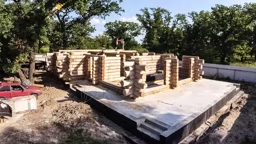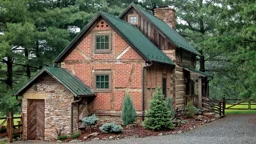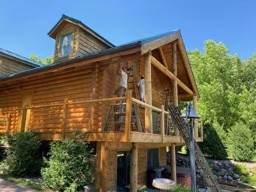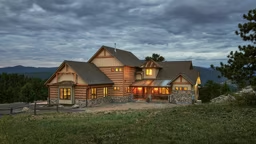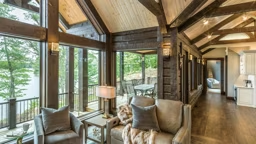

Houses come in all shapes, sizes and styles. But the one thing every home has is common is its owner’s desire to feel safe and sound. The key to a secure home is to be sure you have a proper foundation. Here’s how.
First things first, identify your soils and your terrain. These factors will impact the type of foundation you need. There are many foundation options in the marketplace, from pour-in-place solid concrete to masonry concrete blocks to pre-cast concrete to insulating concrete forms (ICFs). Each are available in a variety of widths to support the lateral load of your home. Your builder should guide you as to what type is appropriate for your project.
Then identify the log style and weight load that will be sitting on that foundation. This will determine the size of the footers (in-ground supports beneath your foundation) you need, and impact the size and thickness of the foundation’s walls.
Next, you install the subfloor, which is usually made of two layers of moisture-resistant plywood. The subfloor sits atop of the foundation and then the logs sit on the subfloor, which is why laying a foundation with the proper width and strength to support both the subfloor and the log package is such an important starting point. Needless to say, the accuracy of the foundation and its relationship to the log structure needs to be extremely accurate.
For example you wouldn’t want your foundation to be smaller than your log profile, even by a couple of inches. If there is a miscalculation and your foundation is too small, your subfloor may hang over the foundation wall. Then, when you stack the logs on top of the subfloor and the weight of the wood is being transferred directly through that subfloor, you’ll have an uneven proportion of the weight resting on an area that’s unsupported, which could lead to your logs shifting or, worse, your subfloor breaking.
 It’s ok to have a minimal (1/2 to 3/4 inch) overhang of your log profile, especially if you plan to encase your foundation in decorative stone which will come up beneath the overhang and provide additional support. (You need to have a layer of flashing between the stone and the log to provide a moisture barrier between the rock and the wood.)
It’s ok to have a minimal (1/2 to 3/4 inch) overhang of your log profile, especially if you plan to encase your foundation in decorative stone which will come up beneath the overhang and provide additional support. (You need to have a layer of flashing between the stone and the log to provide a moisture barrier between the rock and the wood.)
Just like you don’t want logs to hang over the foundation, you don’t want them to be recessed from the edge of the foundation, either. A flat ledge of a few inches or more will allow rain and snow to collect and rest against the bottom course of your log wall.
Now, if you are using round or D-shaped logs, depending on the profile depth you could allow a half-inch reveal on a D-shaped profile to a 1-1/2-inch reveal with a round log. In this case, it’s ok for that portion of the log wall to hang over the foundation because the flat cut on the base of the log will be what sits on top of the subfloor and bears the log load.
Some manufacturers, depending on their fastening system, require that the subfloor be bolted into the foundation. This is a good idea, especially if you are in an area prone to extreme high winds or seismic activity. You want your foundation to be physically attached to the subfloor structure and, from there, attach the logs through the subfloor and into the foundation itself. In addition, foundations typically employ the use of anchor bolts spaced according to the local code requirements. These anchor bolts hold down what’s known as the “green plate,” which allows the builder to make adjustments to ensure the foundation is level.

In any home, it’s important to ensure that your foundation and subfloor are as level as possible, but in a log home, its absolutely essential. If it’s not level, not only could it harm the long term structural integrity of your log walls, it could also cause the home to look like it’s leaning, due to the horizontal lines that are created by the logs themselves. And unlike a brick or sided home, there’s nowhere to for a builder to hide variations in level.
Your builder or general contractor should be checking for level throughout the foundation installation process, no matter what type of system you use. But in the case of a poured-concrete or ICF foundation, your contractor should ensure that the forms are level before the concrete is actually poured into pace. It’s much easier to make adjustments to the form than to try to shim it once the concrete is cured.
Keep in mind that getting a long span of material to be absolutely level is a challenging task. A variance of about a half inch from end to end is acceptable, but you don’t want to get more than 1 inch from one wall to another, as it will create problems when it comes time to trim out the inside or seeing that sloping line on the outside. A good builder will keep those variances within that half-inch range and then come back and re-level your subfloor with shims. It’s easier to make corrections at this point than after the logs have been stacked on top of it. With everything secure and level, then you can erect the log walls.
So how do the logs, themselves, attach to the subfloor? There are several fastening methods and manufacturers available. Often, metal straps are used. These straps are poured into the foundation and then they reach up and wrap around your joist or your floor trusses. From there you bolt (e.g., a thru-bolt) and/or lag-in the truss members to the foundation. For instance, on your foundation wall, your green plate would be bolted down with anchor bolts, then the straps would come up and reach over the top to grab hold of the floor trusses. The floor truss is then anchored, and, from there, the logs stack on top of that and are bolted into the truss member — not the plywood — that’s secured to the foundation. Is it a little tougher to do that? Yes. Does it take some time to identify those key joinery points? Of course. But combined with the right size and type of foundation and proper footers, these are the keys to constructing a solid, secure log home.
Dan Mitchell owns Eagle CDI in Tennessee and has built close to 100 log homes in his 30-year career. He was the Knoxville Home Builders Association 2015 Builder of the Year.




